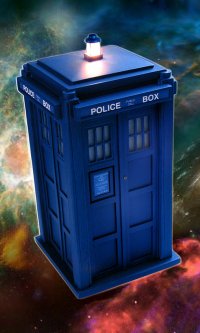
The TARDIS is the Doctor's time machine. The letters T A R D I S stand
for
Time
And
Relative
Dimension
In
Space.
Although the Time Lords have created many models of TARDIS, the Doctor's is an obsolete type 40.
The Doctor obtained his TARDIS only by stealing, or 'borrowing' as he would
say, it from Gallifrey many centuries ago: the model is now obsolete and considered a museum
piece. TARDISes used by the Master and the Rani are largely similar, although slightly more
advanced; a slight incompatibility between circuits means it is unlikely that parts from one
type of TARDIS can be safely replaced by those from another model.
In appearance, the TARDIS looks like an English police telephone box from Earth during the 1960s.
Close up, however, it is apparent that the wooden lock-up is more than it seems: it hums discernibly,
giving away the fact that there is a powerful source of energy beneath its battered blue exterior.
According to the Doctor, the TARDIS is virtually indestructible, although he can be sometimes be
panicked into believing otherwise. For added safety, however, the hostile action displacement system
(HADS) or the TARDIS force field can be activated.
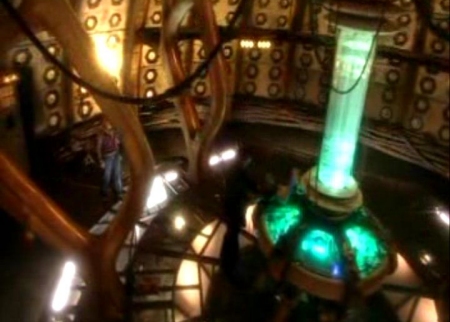
Inside, the TARDIS is far larger than its external appearance suggests: it transcends the three
primary dimensions of the universe. Most of the TARDIS, therefore, exists in another dimension:
only part of the time machine materializes when it lands. The TARDIS's doors open into the console
room, the location of the time ship's main controls. Beyond the console room, through two
ordinary-looking doors, lies the rest of the Doctor's time machine: a confusing maze of corridors
and chambers that even the Doctor has been known to get lost in.
TARDIS Features
Chameleon circuit
The Doctor's TARDIS resembles a police box only because of a fault in the chameleon circuit. TARDISes
ordinarily look like silver-grey metallic boxes but because this makes them conspicuous, the Time Lords
devised a means of disguising them. The chameleon circuit analyses the surroundings of the TARDIS just
before the ship materializes and picks an outward form that blends in. A TARDIS materializing on a
public beach in Edwardian times might appear as a bathing machine; in a Saxon church it might appear
as a crudely carved altar or column. Although the Doctor has made an attempt at repairing the chameleon
circuit of his TARDIS, his ship remains in the form appropriate to England in the 1960s; his meddling
only resulted in even more bizarrely out of place forms.
Cloisters
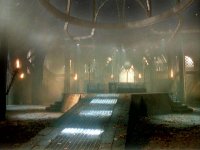
Finished in carefully worked and carved grey stone over which climbing plants grow, the cloisters is a
tranquil area that resembles its monastic equivalent on Earth. The Doctor sometimes retreats to the
cloisters, sitting himself on one of the stone benches or pacing up and down, in order to think clearly
about a problem. The Eye of Harmony is located in the cloisters.
Cloister bell
The deep, resounding knell of the cloister bell is a warning that the TARDIS is in great danger, perhaps
on the verge of breaking up or entering an area where conditions are so hostile that the ship would be
destroyed. Originating from the cloisters, the sound of the bell reverberates through the ship, penetrating
every room.
Control console
Most of the TARDIS's functions are controlled from the hexagonal, sloping-topped console that surrounds
the time rotor in the main control room. Each incarnation of the Doctor has modified the console in some
way, even changing its appearance, to take advantage of new components or to repair damage caused by
circuit fires or even blaster damage.
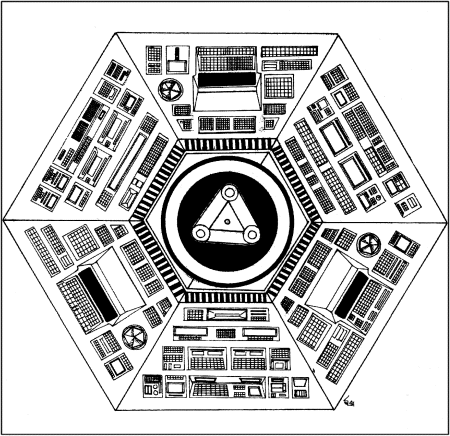
The six trapezoidal panels each house controls for different aspects of the TARDIS's operation. Panel one,
nearest the TARDIS doors, houses the basic navigation and steering controls. It is from here that the Doctor
sets a course for the TARDIS and initializes dematerialization and materialization.
Moving clockwise, viewed from above, panel two houses the switch that opens and closes the TARDIS's doors
and the controls for the scanner. It contains advanced navigational controls that are required in exceptional
circumstances only and the TARDIS's defensive controls.
Panel three houses the communications, life support and lighting controls, as well as the room controls. Panel
four houses the terminal that gives access to the TARDIS's computer and databanks.
Panel five provides readouts of external and internal environmental conditions, including radiation, humidity
and oxygen levels. Panel six indicates the power status of the TARDIS and is used to bring in auxiliary power
from generators and batteries. It provides a power outlet for equipment to be used in the control room or a
short distance outside the TARDIS.
Access to circuits to carry out repairs is obtained by prising off the control panels or by removing the
panels on the pedestal that supports the console.
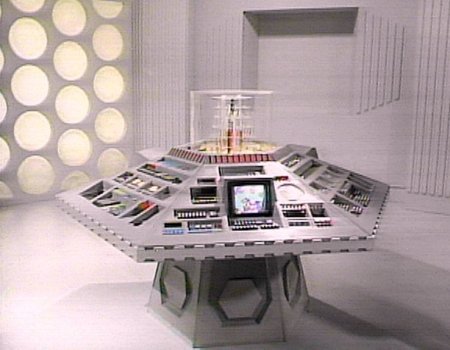 Control room
Control room
The control room is the first room that anyone enters when stepping into the TARDIS. Its main feature is
the control console which is set in the centre of the room. Cream-coloured plastics panels cover the walls,
with circular mouldings, about 30 centimetres across, concealing electronic circuits and lights. Each Doctor
tends to decorate with control room with different objects: the first Doctor favoured ornaments, such as
clocks, on pedestals and even a comfortable armchair. Near the TARDIS's doors, a hatstand is practically
positioned to keep hats and cloaks for expeditions outside.
Dematerialization circuit
Without a working dematerialization circuit, the TARDIS cannot travel anywhere. The Time Lords disabled
this circuit when they exiled the Doctor to Earth; he spent much time tinkering with it in order to escape
from the planet.
Dimensional stabilizer
The dimensional stabilizer maintains the spatial relationship of the inside and the outside of the TARDIS.
Without it, the inside of the TARDIS would shrink so that its rooms resembled those of a doll's house.
Once protected by a number of anti-tampering devices, the lock on the outside of the TARDIS door can be
opened only by a specially coded key. The Doctor has removed other forms of security owing to the risk of
sealing the TARDIS for ever.
Eye of Harmony
Time travel requires an almost infinite amount of power and expends nearly limitless amounts of energy.
In order for this to be possible the TARDIS has a unique energy source, a black hole known as the Eye
of Harmony! The Eye of Harmony, a black hole, was captured and contained in a monolith stored under the
Panopticon on Gallifrey by Rassilon himself, is the source of the energy which powers all Time Lord
technology including TARDISes.

The only way possible for the Eye of Harmony to power a TARDIS is for the Eye itself to be located in the
actual structure of the TARDIS it is powering. Located in the center of the cloister room is the portal of
the Eye of Harmony. The only way possible for one structure to coexist simultaneously in more than one
place is by the use of temporal physics, the science of Time Lord technology.
Failsafe switch
Located away from the main control room, the failsafe switch stabilizes the TARDIS in space and time so
that it may neither materialize nor dematerialize. Until the switch is reactivated, the TARDIS is suspended
in space and time; the switch can be disabled to prevent its unauthorized use.
Food dispenser
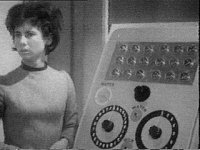
Nutritious, concentrated food can be contained from the TARDIS's food dispenser, located in a room near to
the control room, by entering the type of food required into the dispenser's computer. The food resembles
the concentrated rations used by astronauts from twentieth century Earth during the planet's first space age.
The dispenser also issues water in small plastic bags. Although the food is tasty and filling, many companions
not surprisingly long for proper Earth meals complete with all the trimmings.
Force field
The TARDIS has a variable strength force field that can be used to keep enemies at bay, provided it is
activated. The force field surrounds the TARDIS at a distance of about one metre, preventing both entry
and egress. At its lowest level it is equivalent to Strength 10; its maximum depends on the energy available
from the TARDIS's generators. The force field generator is located in the pedestal section of the control
console and can be detached for use outside the TARDIS.
Hostile action displacement system (HADS)
HADS protects the TARDIS against attack by dematerializing it and rematerializing the ship a safe distance
away. The HADS circuit detects the build up and imminent release of energy, and triggers the dematerialization
circuit so that the TARDIS makes a short spatial journey. The Doctor, however, tends not to activate this
safeguard, mainly because it can make the TARDIS difficult to find and reach.
Rooms

Each companion is assigned his own room in the TARDIS, which he is allowed to personalize. Companions' rooms
are typically full of souvenirs from their travels or equipment for their hobbies: Nyssa's room, for example,
was partly a bioelectronics lab!
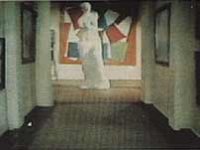
Other rooms in the TARDIS include a power station disguised as an art gallery, a large boot cupboard, and a
wardrobe room. The layout, type and number of rooms in the TARDIS can be controlled from the main control
console. Particular emergencies may make it necessary to shed part of the TARDIS's internal structure, and
he controls allow rooms to be jettisoned. New chambers usually show the basic structure of the TARDIS, which
resembles Victorian ironwork, unless the Doctor remembers to program their features.
Scanner

A large television screen suspended in the wall of the control room provides an image of the location
corresponding to the temporal and spatial coordinates of the TARDIS. It is connected to externally
mounted detection equipment.
Storerooms
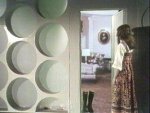
Among the many chambers of the TARDIS are vast storerooms that contain essential supplies and materials
necessary to the upkeep of both the TARDIS and its inhabitants. The list of their contents was once kept
in the TARDIS's databanks, but the Doctor's poor bookkeeping means that this information is far from up
to date -- perhaps as much as five centuries old! -- and may well be inaccurate about the location of
equipment.
Swimming pool

The swimming pool is the main feature of a villa-style courtyard that is decorated with white pillars
and urns. There is an abundance of plant life in this area: climbing plants creep up the pillars and
over stone balconies; the urns contain more formal arrangements. Artificial sunlight makes the courtyard
bright and pleasant -- an ideal place to relax.
TARDIS key

Although the key to the TARDIS looks no more complicated than a front-door key, its complex crystalline
coding is unique and attuned to the body prints of the Doctor and whichever companions he decides are
trustworthy enough to be allowed free access to the TARDIS. The key and lock can be reprogrammed from
the main control console. If necessary, the Doctor can issue a spare key to his companions, but he
dislikes the risk this entails: his enemies might one day prove clever enough to use a companion and
the key to steal his ship.
Time rotor

The time rotor at the centre of the control console rises and falls as the TARDIS travels through time
and space. While the ship is stationary, however, the time rotor is motionless.
Workshop

Deep in the TARDIS is a scientific workshop where the Doctor has the facilities to build and repair
electronic and mechanical equipment. It has no pretences of advanced technology: ancient scientific
apparatus mingles with new and futuristic equipment.
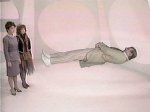 Zero room
Zero room
The zero room isolates its inhabitants from the forces of the universe, allowing them more easily to
attain a peaceful state. The Doctor needed to use the zero room to settle into his fifth incarnation,
making use of its therapeutic properties.
 The TARDIS is the Doctor's time machine. The letters T A R D I S stand
for Time And Relative Dimension In Space.
Although the Time Lords have created many models of TARDIS, the Doctor's is an obsolete type 40.
The Doctor obtained his TARDIS only by stealing, or 'borrowing' as he would
say, it from Gallifrey many centuries ago: the model is now obsolete and considered a museum
piece. TARDISes used by the Master and the Rani are largely similar, although slightly more
advanced; a slight incompatibility between circuits means it is unlikely that parts from one
type of TARDIS can be safely replaced by those from another model.
In appearance, the TARDIS looks like an English police telephone box from Earth during the 1960s.
Close up, however, it is apparent that the wooden lock-up is more than it seems: it hums discernibly,
giving away the fact that there is a powerful source of energy beneath its battered blue exterior.
According to the Doctor, the TARDIS is virtually indestructible, although he can be sometimes be
panicked into believing otherwise. For added safety, however, the hostile action displacement system
(HADS) or the TARDIS force field can be activated.
The TARDIS is the Doctor's time machine. The letters T A R D I S stand
for Time And Relative Dimension In Space.
Although the Time Lords have created many models of TARDIS, the Doctor's is an obsolete type 40.
The Doctor obtained his TARDIS only by stealing, or 'borrowing' as he would
say, it from Gallifrey many centuries ago: the model is now obsolete and considered a museum
piece. TARDISes used by the Master and the Rani are largely similar, although slightly more
advanced; a slight incompatibility between circuits means it is unlikely that parts from one
type of TARDIS can be safely replaced by those from another model.
In appearance, the TARDIS looks like an English police telephone box from Earth during the 1960s.
Close up, however, it is apparent that the wooden lock-up is more than it seems: it hums discernibly,
giving away the fact that there is a powerful source of energy beneath its battered blue exterior.
According to the Doctor, the TARDIS is virtually indestructible, although he can be sometimes be
panicked into believing otherwise. For added safety, however, the hostile action displacement system
(HADS) or the TARDIS force field can be activated.

 Finished in carefully worked and carved grey stone over which climbing plants grow, the cloisters is a
tranquil area that resembles its monastic equivalent on Earth. The Doctor sometimes retreats to the
cloisters, sitting himself on one of the stone benches or pacing up and down, in order to think clearly
about a problem. The Eye of Harmony is located in the cloisters.
Cloister bell
The deep, resounding knell of the cloister bell is a warning that the TARDIS is in great danger, perhaps
on the verge of breaking up or entering an area where conditions are so hostile that the ship would be
destroyed. Originating from the cloisters, the sound of the bell reverberates through the ship, penetrating
every room.
Control console
Most of the TARDIS's functions are controlled from the hexagonal, sloping-topped console that surrounds
the time rotor in the main control room. Each incarnation of the Doctor has modified the console in some
way, even changing its appearance, to take advantage of new components or to repair damage caused by
circuit fires or even blaster damage.
Finished in carefully worked and carved grey stone over which climbing plants grow, the cloisters is a
tranquil area that resembles its monastic equivalent on Earth. The Doctor sometimes retreats to the
cloisters, sitting himself on one of the stone benches or pacing up and down, in order to think clearly
about a problem. The Eye of Harmony is located in the cloisters.
Cloister bell
The deep, resounding knell of the cloister bell is a warning that the TARDIS is in great danger, perhaps
on the verge of breaking up or entering an area where conditions are so hostile that the ship would be
destroyed. Originating from the cloisters, the sound of the bell reverberates through the ship, penetrating
every room.
Control console
Most of the TARDIS's functions are controlled from the hexagonal, sloping-topped console that surrounds
the time rotor in the main control room. Each incarnation of the Doctor has modified the console in some
way, even changing its appearance, to take advantage of new components or to repair damage caused by
circuit fires or even blaster damage.


 The only way possible for the Eye of Harmony to power a TARDIS is for the Eye itself to be located in the
actual structure of the TARDIS it is powering. Located in the center of the cloister room is the portal of
the Eye of Harmony. The only way possible for one structure to coexist simultaneously in more than one
place is by the use of temporal physics, the science of Time Lord technology.
Failsafe switch
Located away from the main control room, the failsafe switch stabilizes the TARDIS in space and time so
that it may neither materialize nor dematerialize. Until the switch is reactivated, the TARDIS is suspended
in space and time; the switch can be disabled to prevent its unauthorized use.
Food dispenser
The only way possible for the Eye of Harmony to power a TARDIS is for the Eye itself to be located in the
actual structure of the TARDIS it is powering. Located in the center of the cloister room is the portal of
the Eye of Harmony. The only way possible for one structure to coexist simultaneously in more than one
place is by the use of temporal physics, the science of Time Lord technology.
Failsafe switch
Located away from the main control room, the failsafe switch stabilizes the TARDIS in space and time so
that it may neither materialize nor dematerialize. Until the switch is reactivated, the TARDIS is suspended
in space and time; the switch can be disabled to prevent its unauthorized use.
Food dispenser
 Nutritious, concentrated food can be contained from the TARDIS's food dispenser, located in a room near to
the control room, by entering the type of food required into the dispenser's computer. The food resembles
the concentrated rations used by astronauts from twentieth century Earth during the planet's first space age.
The dispenser also issues water in small plastic bags. Although the food is tasty and filling, many companions
not surprisingly long for proper Earth meals complete with all the trimmings.
Force field
The TARDIS has a variable strength force field that can be used to keep enemies at bay, provided it is
activated. The force field surrounds the TARDIS at a distance of about one metre, preventing both entry
and egress. At its lowest level it is equivalent to Strength 10; its maximum depends on the energy available
from the TARDIS's generators. The force field generator is located in the pedestal section of the control
console and can be detached for use outside the TARDIS.
Hostile action displacement system (HADS)
HADS protects the TARDIS against attack by dematerializing it and rematerializing the ship a safe distance
away. The HADS circuit detects the build up and imminent release of energy, and triggers the dematerialization
circuit so that the TARDIS makes a short spatial journey. The Doctor, however, tends not to activate this
safeguard, mainly because it can make the TARDIS difficult to find and reach.
Rooms
Nutritious, concentrated food can be contained from the TARDIS's food dispenser, located in a room near to
the control room, by entering the type of food required into the dispenser's computer. The food resembles
the concentrated rations used by astronauts from twentieth century Earth during the planet's first space age.
The dispenser also issues water in small plastic bags. Although the food is tasty and filling, many companions
not surprisingly long for proper Earth meals complete with all the trimmings.
Force field
The TARDIS has a variable strength force field that can be used to keep enemies at bay, provided it is
activated. The force field surrounds the TARDIS at a distance of about one metre, preventing both entry
and egress. At its lowest level it is equivalent to Strength 10; its maximum depends on the energy available
from the TARDIS's generators. The force field generator is located in the pedestal section of the control
console and can be detached for use outside the TARDIS.
Hostile action displacement system (HADS)
HADS protects the TARDIS against attack by dematerializing it and rematerializing the ship a safe distance
away. The HADS circuit detects the build up and imminent release of energy, and triggers the dematerialization
circuit so that the TARDIS makes a short spatial journey. The Doctor, however, tends not to activate this
safeguard, mainly because it can make the TARDIS difficult to find and reach.
Rooms
 Each companion is assigned his own room in the TARDIS, which he is allowed to personalize. Companions' rooms
are typically full of souvenirs from their travels or equipment for their hobbies: Nyssa's room, for example,
was partly a bioelectronics lab!
Each companion is assigned his own room in the TARDIS, which he is allowed to personalize. Companions' rooms
are typically full of souvenirs from their travels or equipment for their hobbies: Nyssa's room, for example,
was partly a bioelectronics lab!
 Other rooms in the TARDIS include a power station disguised as an art gallery, a large boot cupboard, and a
wardrobe room. The layout, type and number of rooms in the TARDIS can be controlled from the main control
console. Particular emergencies may make it necessary to shed part of the TARDIS's internal structure, and
he controls allow rooms to be jettisoned. New chambers usually show the basic structure of the TARDIS, which
resembles Victorian ironwork, unless the Doctor remembers to program their features.
Scanner
Other rooms in the TARDIS include a power station disguised as an art gallery, a large boot cupboard, and a
wardrobe room. The layout, type and number of rooms in the TARDIS can be controlled from the main control
console. Particular emergencies may make it necessary to shed part of the TARDIS's internal structure, and
he controls allow rooms to be jettisoned. New chambers usually show the basic structure of the TARDIS, which
resembles Victorian ironwork, unless the Doctor remembers to program their features.
Scanner
 A large television screen suspended in the wall of the control room provides an image of the location
corresponding to the temporal and spatial coordinates of the TARDIS. It is connected to externally
mounted detection equipment.
Storerooms
A large television screen suspended in the wall of the control room provides an image of the location
corresponding to the temporal and spatial coordinates of the TARDIS. It is connected to externally
mounted detection equipment.
Storerooms
 Among the many chambers of the TARDIS are vast storerooms that contain essential supplies and materials
necessary to the upkeep of both the TARDIS and its inhabitants. The list of their contents was once kept
in the TARDIS's databanks, but the Doctor's poor bookkeeping means that this information is far from up
to date -- perhaps as much as five centuries old! -- and may well be inaccurate about the location of
equipment.
Swimming pool
Among the many chambers of the TARDIS are vast storerooms that contain essential supplies and materials
necessary to the upkeep of both the TARDIS and its inhabitants. The list of their contents was once kept
in the TARDIS's databanks, but the Doctor's poor bookkeeping means that this information is far from up
to date -- perhaps as much as five centuries old! -- and may well be inaccurate about the location of
equipment.
Swimming pool
 The swimming pool is the main feature of a villa-style courtyard that is decorated with white pillars
and urns. There is an abundance of plant life in this area: climbing plants creep up the pillars and
over stone balconies; the urns contain more formal arrangements. Artificial sunlight makes the courtyard
bright and pleasant -- an ideal place to relax.
TARDIS key
The swimming pool is the main feature of a villa-style courtyard that is decorated with white pillars
and urns. There is an abundance of plant life in this area: climbing plants creep up the pillars and
over stone balconies; the urns contain more formal arrangements. Artificial sunlight makes the courtyard
bright and pleasant -- an ideal place to relax.
TARDIS key
 Although the key to the TARDIS looks no more complicated than a front-door key, its complex crystalline
coding is unique and attuned to the body prints of the Doctor and whichever companions he decides are
trustworthy enough to be allowed free access to the TARDIS. The key and lock can be reprogrammed from
the main control console. If necessary, the Doctor can issue a spare key to his companions, but he
dislikes the risk this entails: his enemies might one day prove clever enough to use a companion and
the key to steal his ship.
Time rotor
Although the key to the TARDIS looks no more complicated than a front-door key, its complex crystalline
coding is unique and attuned to the body prints of the Doctor and whichever companions he decides are
trustworthy enough to be allowed free access to the TARDIS. The key and lock can be reprogrammed from
the main control console. If necessary, the Doctor can issue a spare key to his companions, but he
dislikes the risk this entails: his enemies might one day prove clever enough to use a companion and
the key to steal his ship.
Time rotor
 The time rotor at the centre of the control console rises and falls as the TARDIS travels through time
and space. While the ship is stationary, however, the time rotor is motionless.
Workshop
The time rotor at the centre of the control console rises and falls as the TARDIS travels through time
and space. While the ship is stationary, however, the time rotor is motionless.
Workshop
 Deep in the TARDIS is a scientific workshop where the Doctor has the facilities to build and repair
electronic and mechanical equipment. It has no pretences of advanced technology: ancient scientific
apparatus mingles with new and futuristic equipment.
Deep in the TARDIS is a scientific workshop where the Doctor has the facilities to build and repair
electronic and mechanical equipment. It has no pretences of advanced technology: ancient scientific
apparatus mingles with new and futuristic equipment.
 Zero room
The zero room isolates its inhabitants from the forces of the universe, allowing them more easily to
attain a peaceful state. The Doctor needed to use the zero room to settle into his fifth incarnation,
making use of its therapeutic properties.
Zero room
The zero room isolates its inhabitants from the forces of the universe, allowing them more easily to
attain a peaceful state. The Doctor needed to use the zero room to settle into his fifth incarnation,
making use of its therapeutic properties.